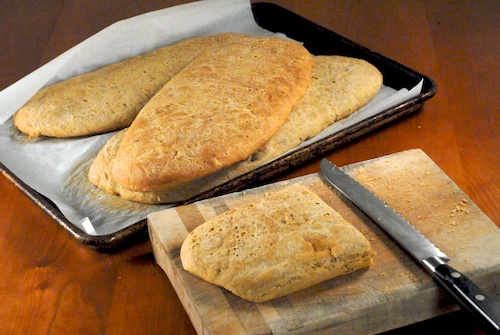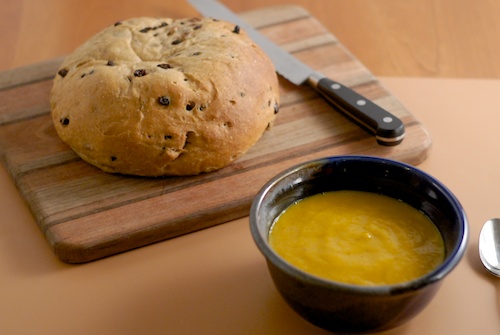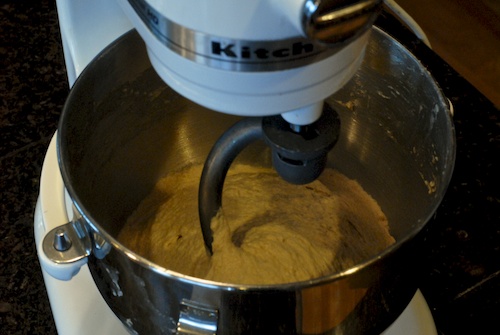
white whole wheat ciabatta loaves
My son loves ciabatta sandwiches so the bread is a staple for us. I’ve been experimenting all fall and winter with making my own ciabatta at home and I think I’ve got it! I’m making ciabatta that’s cheaper, fresher, and with ingredients I want like whole grains, extra virgin olive oil, and filtered water.
Ciabatta dough is known for being sticky in the extreme. It does not come together in a ball when you first mix the dough together, and is too wet and sticky to be hand kneaded. I use a stand mixer, here’s what it looks like when it’s being kneaded:

white whole wheat ciabatta dough in the stand mixer
Usually I remember to brush some olive oil on the loaves before covering them with saran wrap for the final rise, but not this time. The dough stuck to the saran wrap and deflated a bit when I removed it, making the loaves a little flatter than usual. According to the experts at King Arthur Flour, ciabatta in general doesn’t rise very high, usually two inches or less. It needs to be sliced in half the long way for sandwiches like the classic panini. The ciabatta-loving son I bake for is willing to do that to get the sandwiches he wants.
I’m still working on trying to get the big air holes in the bread that are a hallmark of ciabatta and the somewhat higher rise I’ve seen in store-bought loaves. Using almost half white whole wheat flour, as I do, may not help with the rise or with getting those large air pockets, but the texture, flavor, and nutrition are more to my taste.
This batch ended up sitting around in various states of rise all day, since rise times around here happen more around my schedule than the bread’s. That might not always lead to the perfect loaf, but on the other hand, I’ve found the process to be pretty flexible, and a longer rise can help the bread develop better flavor and keeping qualities. The fridge is your friend here, since it will slow down the bread if you need to be out instead of tending it. Sometimes I let the first rise happen overnight in the fridge.
While I originally started with the Ciabatta Integrale from the King Arthur Flour Baking Book and got a lot of tips from that recipe, I also tried another King Arthur Flour recipe, their Harvest Grains Ciabatta. By now I’ve changed things up to where the recipe is my own. I use a vegan protein powder, Soy-Free Veg protein booster, instead of dry milk powder, but you don’t need to use either, according to a communication that I got from KAF.
In a ploy to keep ciabatta in stock without too much fuss for me, I’ve been making a double recipe of this, yielding four loaves, and putting three in the freezer. For you, I’ll write out a regular recipe yielding two loaves.
Michelle Garcia had a great looking loaf of 100% white whole wheat ciabatta on the previous incarnation of her blog The Musician Who Cooks. Her technique sounds a bit labor-intensive, but I can’t argue with how high her loaf rose. She mixes all the ingredients first and does four to six short rises with a gentle stretch-and-fold of the bread between each rise, all before the dough takes an overnight rest in the fridge. I’m going to have to try the stretch and fold technique next!
- Pre-ferment:
- 1 cup white whole wheat flour
- ½ cup plus 1 Tbsp. room temperature water
- heavy pinch of baking yeast
- Dough:
- the starter
- 2 cups unbleached all-purpose flour
- ¾ cup white whole wheat flour
- 1½ tsp. baking yeast
- 1 Tbsp. coconut sugar or other sugar
- 1¼ tsp. salt.
- 1 Tbsp. vegan protein powder (completely optional)
- ¾ cup plus 2 Tbsp. lukewarm water
- 2 Tbsp. extra virgin olive oil, plus a little more for brushing the tops of the loaves.
- For the pre-ferment: In a small bowl, stir together 1 cup plus 1 Tbsp. cool water with 1 cup white whole wheat flour and a pinch of baking yeast. Cover bowl with plastic wrap, let sit at room temperature overnight (or all day).
- For the dough, combine starter with all remaining ingredients. I use a stand mixer with a paddle attachment to combine the dough. Once or twice I may have to stop the machine (and unplug it for extra caution), remove the dough from the paddle, and hand-combine a little with the rest of the ingredients. I then let the machine mix it the rest of the way. Once it's all combined, I switch to the dough hook and blend it for about 6 minutes. The dough is very wet and never comes into a ball like regular bread dough.
- Grease a large bowl with olive oil, place dough in bowl and cover with plastic wrap. Allow to rise until doubled in size, about 1½ hours.
- Gently deflate the dough.
- I let it rise a second time for about an hour, but this is optional.
- Gently deflate the dough again, divide into halves.
- Roll each half into a log, about 10".
- Cover a baking sheet with parchment paper, place logs on baking sheet.
- Brush tops of loaves with olive oil.
- Cover with plastic wrap and allow to rise until very puffy, 1 to 1½ hours.
- Preheat oven to 425 degrees.
- You may take more or less elaborate steps to 'steam' the oven, or skip this. One way is to place a bowl of steaming hot water into the oven, another is to mist the loaves with lukewarm water right before putting them in the oven.
- Bake for 20 to 25 minutes. When they are done they will have a hollow thump when tested and will turn golden brown.







{ 14 comments… read them below or add one }
Ciabatta is my favorite bread, hands down. I love that you make yours at home! I’m not a bread baker; it’s the one thing I’ve never challenged myself to do. Maybe I’ll try yours!
kristy recently posted..bite-size shrimp, bacon & tomato sandwiches with homemade mayo
Hi Kristi, I’m definitely more of a cook than a baker but it is fun to see if I can make breads like the ones from our local bakeries. The next one I’ve been working on is Rosemary Diamante.
mary recently posted..Potato Enchiladas Verdes
Ciabatta is one bread I never tried making at home – didn’t know it was so sticky. These look like they would make great sandwiches! Perfect for the panini press. I’m glad to find a kindred spirit who can’t resist a beautiful squash!
Reeni recently posted..Italian Meatball Soup
Yup, we are both fans. You have a deep menu of squash recipes on your blog, great resource for that big basket of winter squash in my kitchen!
Happy New Year Mary. Your ciabatta looks so delicious, wish I had some right now!
Ivy recently posted..How to make the perfect Risotto and A Marathon of Risotto Recipes
Thanks, Ivy, Happy New Year to you!
mary recently posted..Chocolate Porter Cake
Wow…I would have never attempted to make them…you make it sound so easy. Looks delicious. I must try this one;)
Nina recently posted..Healthy – Baked Taro Chips
Nina, you are such an accomplished baker– povitica! doughnuts! Lots of things I’ve never tried that look very challenging. This one will be a cakewalk by comparison.
mary recently posted..Keeping Away the Gloom of Northwest Winter
Oh I Love this idea!! I have not tried to make ciabatta myself but it is one of my favorites!! I will have to try out your recipe!
Thanks, Julia, and thanks for checking out my blog and leaving a comment!
Ciabatta bread is my fav! You’re son has good tastes 🙂
Matt recently posted..P&G eStore
That he does, I approve!
I love ciabatta! I used to work in a sandwich shop that used a rosemary/olive oil ciabatta for all of their paninis and I definitely remember those giant holes in the bread that you’re talking about (I also might never get the smell of that bread out of my head… holy delicious). I’ve never really seen a wheat version though (and actually I’ve never used white whole wheat flour before). I’ll have to try that some time to recreate a healthier version of their bread!
Meghan recently posted..Sweet Cream Ice Cream with Pistachios, Dark Chocolate and Balsamic Reduction Swirl
Yep, I want those big holes in mine. Working on it…. You should try white whole wheat flour, it’s very mild-flavored. You can replace one-third of the white flour with white whole wheat in almost any recipe without negative effects.